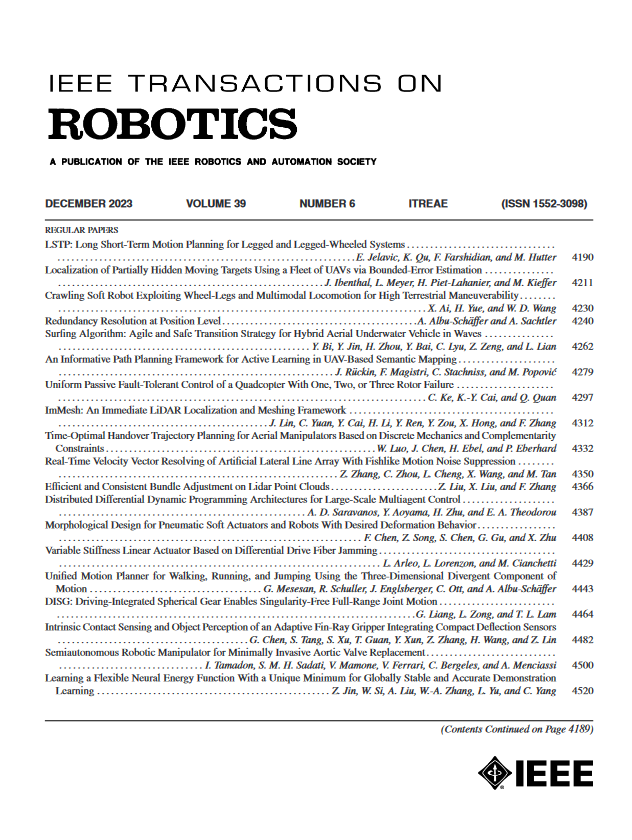iFEM2.0:基于视觉的触觉传感器的密集三维接触力场重建与评估
IF 9.4
1区 计算机科学
Q1 ROBOTICS
引用次数: 0
摘要
基于视觉的触觉传感器通过高分辨率的触觉图像提供丰富的触觉信息,能够在传感器表面重建密集的接触力场。然而,准确地重建三维接触力分布仍然是一个挑战。在本文中,我们提出了多层逆有限元法(iFEM2.0)作为一种鲁棒和广义的方法来重建密集接触力分布。我们系统地分析了iFEM2.0框架内的各种参数,并通过仿真和现场机械校准确定了合适的参数组合。我们的方法结合了多层网格约束和脊正则化来增强鲁棒性。此外,由于没有现成的测量设备或标准度量存在于三维接触力分布感知,我们提出了一个涵盖精度,保真度和抗噪声的基准,可以作为其他未来力分布重建方法的基石。所提出的iFEM2.0在基于仿真和实验的评估中都表现出良好的性能。这种密集的三维接触力信息对于实现灵活的机器人操作至关重要,可以处理刚性和软质材料。本文章由计算机程序翻译,如有差异,请以英文原文为准。
iFEM2.0: Dense 3-D Contact Force Field Reconstruction and Assessment for Vision-Based Tactile Sensors
Vision-based tactile sensors offer rich tactile information through high-resolution tactile images, enabling the reconstruction of dense contact force fields on the sensor surface. However, accurately reconstructing the 3-D contact force distribution remains a challenge. In this article, we propose the multilayer inverse finite-element method (iFEM2.0) as a robust and generalized approach to reconstruct dense contact force distribution. We systematically analyze various parameters within the iFEM2.0 framework, and determine the appropriate parameter combinations through simulation and in situ mechanical calibration. Our approach incorporates multilayer mesh constraints and ridge regularization to enhance robustness. Furthermore, as no off-the-shelf measurement equipment or criterion metrics exist for 3-D contact force distribution perception, we present a benchmark covering accuracy, fidelity, and noise resistance that can serve as a cornerstone for other future force distribution reconstruction methods. The proposed iFEM2.0 demonstrates good performance in both simulation- and experiment-based evaluations. Such dense 3-D contact force information is critical for enabling dexterous robotic manipulation that handles both rigid and soft materials.
求助全文
通过发布文献求助,成功后即可免费获取论文全文。
去求助
来源期刊

IEEE Transactions on Robotics
工程技术-机器人学
CiteScore
14.90
自引率
5.10%
发文量
259
审稿时长
6.0 months
期刊介绍:
The IEEE Transactions on Robotics (T-RO) is dedicated to publishing fundamental papers covering all facets of robotics, drawing on interdisciplinary approaches from computer science, control systems, electrical engineering, mathematics, mechanical engineering, and beyond. From industrial applications to service and personal assistants, surgical operations to space, underwater, and remote exploration, robots and intelligent machines play pivotal roles across various domains, including entertainment, safety, search and rescue, military applications, agriculture, and intelligent vehicles.
Special emphasis is placed on intelligent machines and systems designed for unstructured environments, where a significant portion of the environment remains unknown and beyond direct sensing or control.
 求助内容:
求助内容: 应助结果提醒方式:
应助结果提醒方式:


